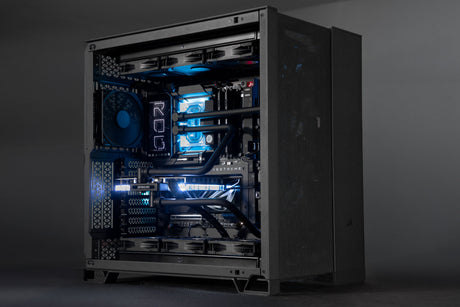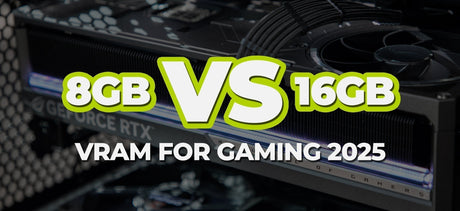CUDIMM vs. UDIMM : The Next Leap in High-Speed Desktop Memory?
In the ever-evolving world of PCs, manufacturers are constantly experimenting with ways to push technology forward. The laptop market has seen the arrival of CAMM and LPCAMM memory solutions, and shortly we will begin seeing desktop solutions built around Clocked Unbuffered DIMMs (CUDIMM) memory modules. But what exactly is CUDIMM, and how does it differ from the traditional UDIMM modules that we use in our desktop PCs today? Let’s dive into the details to see how CUDIMMs aim to redefine DDR5 performance and take memory capabilities to the next level.
What is UDIMM?
UDIMM stands for Unbuffered Dual In-Line Memory Module. It’s the most common type of memory module you’ll find in consumer desktops and laptops. Here’s a quick breakdown:
- Direct CPU Connection: UDIMMs connect directly to the CPU’s memory controller, ensuring low latency and fast data transfers.
- Cost-Effective: They’re simple in design, making them the go-to choice for most everyday use cases, gaming setups, and home PCs.
- Straightforward Layout: UDIMMs lack additional components like buffers or dedicated clock drivers, keeping their design relatively simple.
While UDIMMs have been solid performers across generations of DDR memory, the rapidly increasing speeds in DDR5 have begun to highlight some limitations, such as challenges with signal integrity. This is where CUDIMMs come into play.
What is CUDIMM?
CUDIMM, or Clocked Unbuffered DIMM, represents a new JEDEC-standardized memory module. It builds on the UDIMM design but introduces a critical component: the Clock Driver (CKD). The CKD is designed to improve signal integrity, especially at the higher speeds demanded by DDR5 and the upcoming DDR6.
Key Features of CUDIMM

- Clock Driver (CKD) Integration: By incorporating a clock driver, CUDIMMs can stabilize and regenerate the clock signal, helping to maintain synchronization between the CPU and memory.
- Enhanced Signal Integrity: The CKD helps address issues like clock skew and jitter, leading to more reliable operation at higher memory speeds.
- Backward Compatibility: CUDIMMs retain the same 288-pin connection as standard DDR5 UDIMMs, ensuring compatibility with existing platforms.
UDIMM vs. CUDIMM: The Core Differences
1. Clock Signal Management
- UDIMM: Relies directly on the CPU’s clock signal, which can become problematic as speeds increase.
- CUDIMM: Includes a dedicated clock driver, reducing signal degradation and allowing for more stable operation at high speeds like DDR5-6400 and beyond.
2. Performance and Stability
- UDIMM: Prone to clock skew and jitter at higher speeds, potentially leading to system instability.
- CUDIMM: The clock driver effectively mitigates these issues, improving performance and stability, particularly in demanding scenarios.
3. Design Complexity and Cost
- UDIMM: A simpler, more cost-effective option, ideal for mainstream applications.
- CUDIMM: Adds a clock driver, slightly increasing complexity and cost but delivering greater stability at higher speeds without the full expense of a buffered RDIMM.
Compatibility Considerations: Ryzen and Intel
When deciding between UDIMMs and CUDIMMs, it's essential to factor in CPU compatibility:
- AMD Ryzen 7000 Series: These CPUs don’t support CUDIMMs. Attempting to install one results in a system that won’t boot.
- AMD Ryzen 8000 and 9000 Series: Support for CUDIMMs is limited to bypass mode, effectively disabling the clock driver and neutralizing its benefits.
- Designed for Intel Arrow Lake Platform: Intel’s Arrow Lake CPUs will be the first to fully leverage the advantages of CUDIMMs, enabling higher and more stable memory speeds.
Why Do We Need CUDIMMs?

As DDR5 speeds push beyond 6400 MT/s, traditional UDIMMs face increasing challenges in maintaining signal integrity due to electrical limitations. In UDIMMs, the CPU’s memory controller carries most of the load, which can lead to instability, especially in high-density configurations.
CUDIMMs address this by placing part of the clock management on the DIMM itself. The CKD amplifies the clock signal, performs phase adjustments, and reduces clock skew and jitter, resulting in a more robust and stable connection between the CPU and memory.
CUDIMMs vs. RDIMMs: A Practical Half-Step Solution
While RDIMMs (Registered DIMMs) are common in servers due to their comprehensive buffering, they’re often overkill for consumer PCs. RDIMMs buffer not only the clock signal but also command and address signals, providing all-encompassing stability but at a higher cost and complexity.
CUDIMMs, on the other hand, offer a more targeted solution by focusing only on the clock signal, making them a cost-effective middle ground between UDIMMs and RDIMMs. They strike a balance between improved stability and affordability, making them ideal for high-performance consumer desktops.
Future-Proofing with CUDIMMs
According to JEDEC’s new JESD323 standard, CUDIMMs will be essential for achieving stable operation at high DDR5 speeds. They’re expected to be backward compatible with existing DDR5 platforms, operating in a lower-speed PLL Bypass Mode with older systems. This flexibility means you can invest in CUDIMMs now and be ready to scale up to higher speeds as new motherboards and CPUs emerge.
Final Thoughts
As DDR5 speeds continue to rise, traditional UDIMMs are starting to show their limitations in terms of signal integrity. CUDIMMs offer an innovative way to address these challenges by integrating a clock driver, enabling more stable and reliable memory performance at higher speeds. For those looking to future-proof their systems or build high-speed DDR5 configurations, CUDIMMs are poised to be a game-changer.
At Computer Lounge, we stay on top of emerging technologies to help you keep ahead of the curve. If you’re exploring memory upgrades or have questions about high-performance components, our experts are ready to assist.
Curious About How RAM Really Works?
If you’re wondering how RAM affects your PC and want to dive deeper into optimizing your system, we’ve got you covered! Check out these helpful blogs:
-
Memory Frequency - Busting PC Building Myths!
Curious about memory frequency? Find out the truth behind some common PC building myths.
-
Deciphering Memory: DIMM per Channel and Rank Configurations
Want to know how DIMM configurations impact your memory performance? This blog breaks it down.









